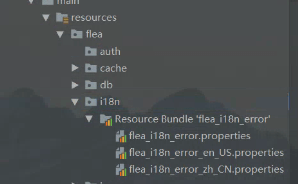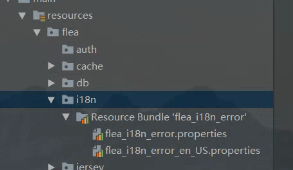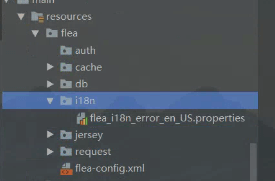1
2
3
4
5
6
7
8
9
10
11
12
13
14
15
16
17
18
19
20
21
22
23
24
25
26
27
28
29
30
31
32
33
34
35
36
37
38
39
40
41
42
43
44
45
46
47
48
49
50
51
52
53
54
55
56
57
58
59
60
61
62
63
64
65
66
67
68
69
70
71
72
73
74
75
76
77
78
79
80
81
82
83
84
85
86
87
88
89
90
91
92
93
94
95
96
97
98
99
100
101
102
103
104
105
106
107
108
109
110
111
112
113
114
115
116
117
118
119
120
121
122
123
124
125
126
127
128
129
130
131
132
133
134
135
136
137
138
139
140
141
142
143
144
145
146
147
148
149
150
151
152
153
154
155
156
157
158
159
160
161
162
163
164
165
166
167
168
169
170
171
172
173
174
175
176
177
178
179
180
181
182
183
184
185
186
187
188
189
190
191
192
193
194
195
196
197
198
199
200
201
202
203
204
205
206
207
208
209
210
211
212
213
214
215
216
217
218
219
220
221
222
223
224
225
226
227
228
229
230
231
232
233
234
235
236
237
238
239
240
241
242
243
244
245
246
247
248
249
250
251
252
253
254
255
256
257
258
259
260
261
|
public class FleaI18nConfig {
private static final FleaLogger LOGGER = FleaLoggerProxy.getProxyInstance(FleaI18nConfig.class);
private static volatile FleaI18nConfig config;
private ConcurrentMap<String, String> resFilePath = new ConcurrentHashMap<>();
private ConcurrentMap<String, ResourceBundle> resources = new ConcurrentHashMap<>();
private FleaI18nConfig() {
init();
}
public static FleaI18nConfig getConfig() {
if (ObjectUtils.isEmpty(config)) {
synchronized (FleaI18nConfig.class) {
if (ObjectUtils.isEmpty(config)) {
config = new FleaI18nConfig();
}
}
}
return config;
}
private void init() {
ConfigItems fleaI18nItems = FleaConfigManager.getConfigItems(CommonConstants.FleaI18NConstants.FLEA_I18N_CONFIG_ITEMS_KEY);
if (ObjectUtils.isNotEmpty(fleaI18nItems) && CollectionUtils.isNotEmpty(fleaI18nItems.getConfigItemList())) {
for (ConfigItem configItem : fleaI18nItems.getConfigItemList()) {
if (ObjectUtils.isNotEmpty(configItem) && StringUtils.isNotBlank(configItem.getKey()) && StringUtils.isNotBlank(configItem.getValue())) {
String[] valueArr = StringUtils.split(configItem.getValue(), CommonConstants.SymbolConstants.COMMA);
if (ArrayUtils.isNotEmpty(valueArr) && CommonConstants.NumeralConstants.INT_TWO == valueArr.length) {
String filePath = StringUtils.trim(valueArr[0]);
String fileNamePrefix = StringUtils.trim(valueArr[1]);
if (StringUtils.isNotBlank(filePath) && StringUtils.isNotBlank(fileNamePrefix)) {
String configResFilePath;
if (CommonConstants.SymbolConstants.SLASH.equals(StringUtils.subStrLast(filePath, 1))) {
configResFilePath = filePath + fileNamePrefix;
} else {
configResFilePath = filePath + CommonConstants.SymbolConstants.SLASH + fileNamePrefix;
}
resFilePath.put(configItem.getKey(), configResFilePath);
}
}
}
}
}
String defaultResFilePath = CommonConstants.FleaI18NConstants.FLEA_I18N_FILE_PATH +
CommonConstants.FleaI18NConstants.FLEA_I18N_FILE_NAME_PREFIX;
resFilePath.put(CommonConstants.SymbolConstants.ASTERISK, defaultResFilePath);
}
public FleaI18nData getI18NData(String key, String[] values, String resName, Locale locale) {
return new FleaI18nData(key, this.getI18NDataValue(key, values, resName, locale));
}
public FleaI18nData getI18NData(String key, String resName, Locale locale) {
return new FleaI18nData(key, this.getI18NDataValue(key, resName, locale));
}
public String getI18NDataValue(String key, String[] values, String resName, Locale locale) {
String value = getI18NDataValue(key, resName, locale);
if (ArrayUtils.isNotEmpty(values)) {
StringBuilder builder = new StringBuilder(value);
for (int i = 0; i < values.length; i++) {
StringUtils.replace(builder, CommonConstants.SymbolConstants.LEFT_CURLY_BRACE + i + CommonConstants.SymbolConstants.RIGHT_CURLY_BRACE, values[i]);
}
value = builder.toString();
}
return value;
}
public String getI18NDataValue(String key, String resName, Locale locale) {
Object obj = null;
if (LOGGER.isDebugEnabled()) {
obj = new Object() {
};
LOGGER.debug1(obj, "Find the key : {}", key);
LOGGER.debug1(obj, "Find the resName : {}", resName);
LOGGER.debug1(obj, "Find the locale : {} , {}", locale == null ? Locale.getDefault() : locale, locale == null ? Locale.getDefault().getDisplayLanguage() : locale.getDisplayLanguage());
}
ResourceBundle resource = getResourceBundle(resName, locale);
String value = null;
if (ObjectUtils.isNotEmpty(resource)) {
value = resource.getString(key);
if (StringUtils.isBlank(value)) {
value = key;
}
}
if (LOGGER.isDebugEnabled()) {
LOGGER.debug1(obj, "Find the value : {} ", value);
}
return value;
}
private ResourceBundle getResourceBundle(String resName, Locale locale) {
String key = generateKey(resName, locale);
Object obj = null;
if (LOGGER.isDebugEnabled()) {
obj = new Object() {
};
LOGGER.debug1(obj, "Find the resKey : {}", key);
}
ResourceBundle resource = resources.get(key);
StringBuilder fileName = new StringBuilder(getResFilePath(resName));
if (StringUtils.isNotBlank(resName)) {
fileName.append(CommonConstants.SymbolConstants.UNDERLINE).append(resName);
}
if (LOGGER.isDebugEnabled()) {
if (ObjectUtils.isEmpty(locale)) {
LOGGER.debug1(obj, "Find the expected fileName: {}.properties", fileName);
} else {
LOGGER.debug1(obj, "Find the expected fileName: {}_{}.properties", fileName, locale);
}
}
if (ObjectUtils.isEmpty(resource)) {
if (ObjectUtils.isEmpty(locale)) {
resource = ResourceBundle.getBundle(fileName.toString());
} else {
resource = ResourceBundle.getBundle(fileName.toString(), locale);
}
resources.put(key, resource);
}
if (LOGGER.isDebugEnabled()) {
Locale realLocale = resource.getLocale();
if (ObjectUtils.isEmpty(locale) || StringUtils.isBlank(realLocale.toString())) {
LOGGER.debug1(obj, "Find the real fileName: {}.properties", fileName);
} else {
LOGGER.debug1(obj, "Find the real fileName: {}_{}.properties", fileName, realLocale);
}
}
return resource;
}
private String generateKey(String resName, Locale locale) {
String key = "";
if (StringUtils.isNotBlank(resName)) {
key = resName;
if (ObjectUtils.isNotEmpty(locale)) {
key += CommonConstants.SymbolConstants.UNDERLINE + locale;
}
}
return key;
}
private String getResFilePath(String resName) {
String resFilePathStr = resFilePath.get(resName);
if (ObjectUtils.isEmpty(resFilePathStr)) {
resFilePathStr = resFilePath.get(CommonConstants.SymbolConstants.ASTERISK);
}
return resFilePathStr;
}
}
|










